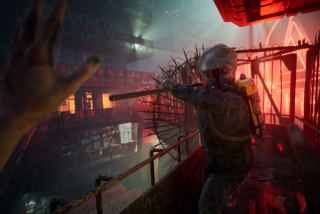A Sampling of First-Person Titles Worth Taking a Shot At
- Share via
Much as it does in writing, the first person tends to get overused in video games. Ever since “Wolfenstein 3-D” exposed the masses to first-person gaming, developers have flooded the market with titles that promise to put players in the middle of the action--often even supplying pithy inner monologues to interpret the action. Who, for instance, could forget Duke Nukem’s challenge to “come get some”?
When done well--which is getting rarer by the day--first-person perspectives create immersing environments that are hard to beat. Three recent PC titles--”Half-Life” from Sierra Studios, “Blood II: The Chosen” from GT Interactive and “Thief: The Dark Project” from Eidos Interactive--demonstrate how artful first-person gaming can be.
Each takes a different tack. “Half-Life” delivers sci-fi adventure gaming with lots of shooting. “Blood II” is a pure blood bath with squirting ooze and lots and lots of gratuitous violence. “Thief” highlights the niches first-person gaming has yet to exploit; rather than brashly killing everything in sight, the game requires players to sneak around most of the time.
Together, the games highlight how far first-person games have come since the primitive square rooms of “Wolfenstein.” And on high-end machines with graphics hardware installed, they create realistic worlds that engross, enthrall and often repulse. Unfortunately, all three carry on an informal tradition in first-person gaming that calls for nasty violence and mature themes.
These are not kids’ games.
“Half-Life”
Sierra Studios offers a great guarantee: Like the game or don’t pay. On a game such as “Half-Life,” that’s a pretty safe bet. It’s tough to imagine someone who likes video games not absolutely loving this gem.
Players assume the role of Dr. Gordon Freeman, a physicist recently employed by the super-secret Black Mesa Research Facility deep beneath the deserts of New Mexico. An experiment goes horribly wrong--do they ever go right?--and the good doctor is forced to arm himself against an array of alien and human nasties.
“Half-Life’s” environments are standard factory-style corridors, but they twist and turn with tons of secret hiding places. Enemies and friends lurk in the shadows. Enemies, of course, are never fun to find. But friendly scientists who survived the experiment can help players navigate. So it’s wise not to enter a room and just start shooting.
Most environments are completely interactive. Players may turn on the hand dryers in the men’s room or push open broken doors. Plus, the materials are realistic. Slippery floors are actually slippery.
These touches make “Half-Life” more than just another run-and-fire corridor shooter.
“Half-Life” requires a Pentium 133 with at least 24 megabytes of RAM and 400mb of free hard-disk space. It runs much better on a faster machine with at least 32mb of RAM and a graphics accelerator card, which permits more detailed environments.
“Blood II: The Chosen”
“Blood II: The Chosen” is about as traditional as shooters come. Sure, innocents get in the way of a firefight, but they’ve usually got it coming. “Blood II” lives up to its name, allowing players to spatter buckets of bad-guy hemoglobin all over the walls and floors of the game’s creepy environments.
Players take on the role of Caleb, an undead dude with an attitude and a penchant for blowing things up. He’s on a mission to rid the world of the cult that hides behind its status as a multinational corporation. Naturally, the culties dress in business attire, which allows frustrated corporate types to live out their fantasy of blowing away suits in dark alleys.
Control is tight and fast, which is good because players are expected to do a fair amount of artful dodging very early in the game.
“Blood II: The Chosen” requires a Pentium 166 with at least 32mb of RAM and a graphics accelerator card. The game can be played without graphics hardware, but only on a Pentium 233 or higher with at least 32mb of RAM. A full installation gobbles up 450mb of hard-disk space.
“Thief: The Dark Project”
“Thief: The Dark Project” demands thought, a rarity in games where simple twitching is generally sufficient to survive. Players assume the role of Garrett, a thief who makes his living liberating riches from the upper crust.
As in games like “Metal Gear Solid,” players must think about their actions and the consequences. Running across a lighted square is only advisable if players enjoy the sting of arrows in their backs or look forward to rotting in jail. Shadows are the thief’s friends, and the only way to sneak through the game’s beautiful levels is to use them.
Sound plays a critical role in the game, and players learn quickly to listen before barging into a room or dashing down a corridor. “Thief’s” only problem: Sometimes control was not what it should have been, and players can find themselves jumping for something more often than necessary.
“Thief: The Dark Project” requires a Pentium 166 with at least 32mb of RAM and a graphics accelerator card. The game can be played without graphics hardware, but only on a Pentium 200 or higher with 32mb of RAM. To see all the visual features, “Thief” should be played on a Pentium 266 or higher with 64mb and a graphics accelerator card.
Times staff writer Aaron Curtiss reviews video games every Monday in The Cutting Edge. To comment on a column or to suggest games for review, send e-mail to aaron.curtiss@latimes.com.
(BEGIN TEXT OF INFOBOX / INFOGRAPHIC)
Essentials
Half-Life
* Platform: PC
* Publisher: Sierra Studios
* ESRB* rating: Mature
* Price: $49.95
* Bottom line: Wow
Thief: The Dark Project
* Platform: PC
* Publisher: Eidos Interactive
* ESRB rating: Mature
* Price: $39.95
* Bottom line: Stole my heart
Blood II: The Chosen
* Platform: PC
* Publisher: GT Interactive
* ESRB rating: Mature
* Price: $49.95
* Bottom line: Gory, creepy, fum
*
Next Week
* “Tetris DX”
* “Gex: Enter the Gecko”
* “Pitfall: Beyond the Jungle”
* “The Legend of Zelda: Link’s Awakening DX”
*
* Entertainment Software Ratings Board
More to Read
The biggest entertainment stories
Get our big stories about Hollywood, film, television, music, arts, culture and more right in your inbox as soon as they publish.
You may occasionally receive promotional content from the Los Angeles Times.










